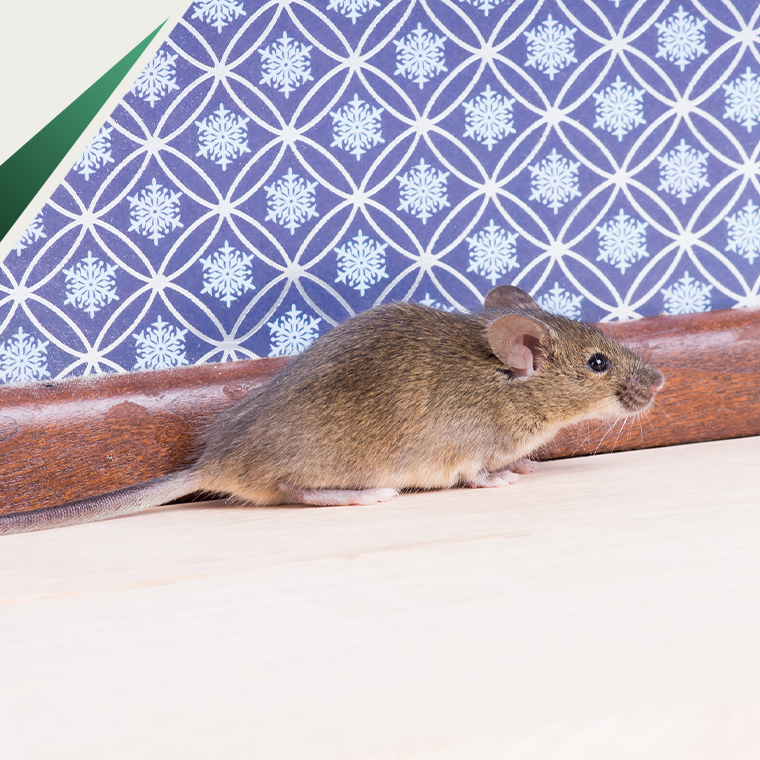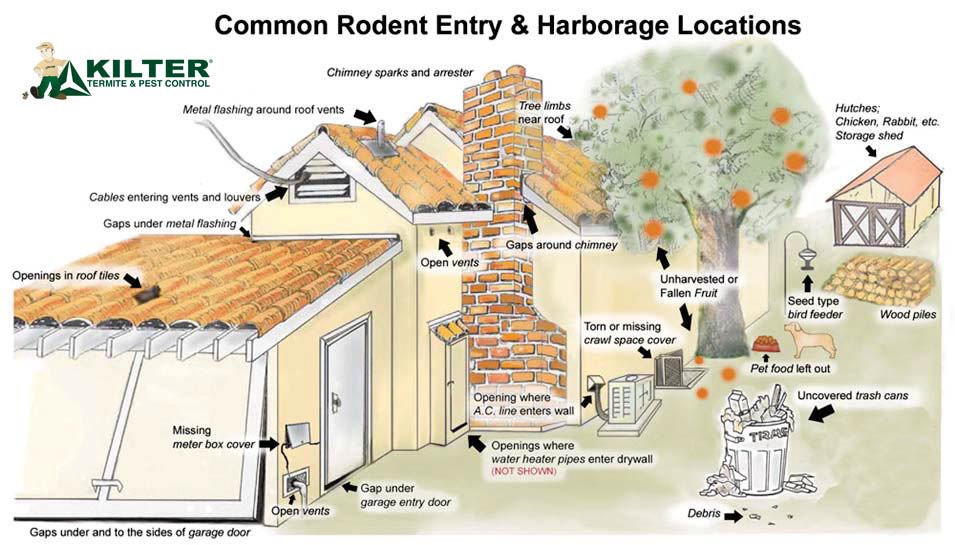
Southern California Rodent Control
Rodent control is a serious matter, we often forget just how many diseases and damage they cause in such a short amount of time. Not only do rodents chew through your home, but they also chew things just to chew. They will bite through the wiring of your home. Many fires per year stem from rodents eating the insulation of the wires, exposing them to the insulation of the wall void. They will create as many entry points as they can, giving themselves access to other areas of your home.
Rodent trapping alone cannot control a rodent infestation. Over 30 years of doing rodent extermination has allowed Kilter Termite and Pest Control to create a system to effectively treat rats and mice in Southern California. We not only trap the rodents but also seal all the holes in the building that they have created and treat the infestation.
You deserve the best! Call (866) 827-1727 for service in San Diego, Temecula, Long Beach, Escondido, Los Angeles, Orange, and surrounding Southern California.


Trusted Services Across SoCal
Whats Bugging You?
Protecting Your Property From Mice & Rats
The most successful and long-lasting form of rat control in structures is exclusion - physically blocking rats and mice from entering your property.
- Seal cracks and openings in building foundations and any openings for water pipes, electric wires, sewer pipes, drain spouts, and vents. No hole larger than 1/4 inch should be left unsealed, in order to exclude both rats and house mice.
- Make sure doors, windows, and screens fit tightly. For areas prone to gnawing, reinforce edges with durable materials like sheet metal.
- Use coarse steel wool, wire mesh, and lightweight sheet metal to plug gaps. Norway and roof rats can easily chew through softer materials like plastic, wood, or caulking, so sturdy materials are essential.
- Seal openings above ground level—both Norway and roof rats are excellent climbers and can enter through vents or gaps near the roofline.
- Pay special attention to roof access points, as roof rats often infiltrate buildings from above.
- If you notice roof rats traveling on overhead utility wires, contact a Southern California rodent professional or your utility company for guidance on prevention measures.
Rodent proofing against roof rats, because of their greater climbing ability, usually requires more time to find entry points than for Norway rats.
Install TAP Insulation and Save with Tax Credits
TAP Pest Control Insulation can only be installed by licensed pest management professionals. If you are told that a product can affect insects, ask to see the EPA label!
Install TAP Pest Control Insulation in your home and earn a tax credit of up to $500! Please call for credit availability. Protect your home and save!
How to Maintain a Rodent-Proof Yard & Home
Sanitation is fundamental to rat control and must be continuous. If sanitation measures aren’t properly maintained, the benefits of other measures will be lost, and rodents will quickly return.
- Good housekeeping in and around buildings will reduce available shelter and food sources for Norway rats and, to some extent, roof rats.
- Neat, off-the-ground storage of pipes, lumber, firewood, crates, boxes, gardening equipment, and other household goods will help reduce the suitability of the area for rats and also make their detection easier.
- Collect garbage, trash, and garden debris frequently, and ensure all garbage receptacles have tight-fitting covers.
- Feed your pet only the amount of food it will eat at a feeding, and store pet food in rodent-proof containers, as rats can become a problem if there is a ready supply of dog food.
- Thin dense vegetation to make the habitat less desirable for roof rats. Climbing hedges such as Algerian or English ivy, star jasmine, and honeysuckle on fences or buildings are conducive to roof rat infestations and should be
- Remove overhanging tree limbs within 3 feet of the roof
- Separate the canopies of densely growing plants such as pyracantha and juniper from one another and from buildings by a distance of 2 feet or more to make it more difficult for rats to move between them.

Why Rodents Invade Your Home
Rats and mice are both capable of entering holes as small as 1/4 of an inch. Rodents use these holes to enter and exit your SoCal home, like it were their own.
- Rats and mice can climb brick, other rough surfaces, inside and outside pipes, and walk on wires.
- Rodents can drop 50 feet without being seriously injured.
- They are able to jump vertically 36 inches and 48 inches horizontally.
- Norway rats can burrow vertically into the earth to a depth of 4 feet.
- Most people do not realize that rodents can swim a mile in open water. They can enter plumbing traps, swim in sewer lines, and swim against substantial currents. Mice are not as good with water as rats, but can manage.
What Else to Know About Rodents
- The teeth of rats grow 4 to 5 inches a year and can prevent them from eating if they do not gnaw them down. They are constantly chewing to get their teeth to the “proper length.”
- Rodents are able to chew through lead sheeting, aluminum, adobe brick, and even concrete!
- Diseases can be transmitted by rodents in several ways, including through bites, as well as indirectly via fleas, ticks, or mites that live on the rodents.
- They contaminate the food and water of your home with their feces and urine. One of the most dangerous situations for rodent exterminators in Southern California is the insulation of attics that has severe urination, as the Hantavirus is contracted this way.
We want your SoCal home to be rodent-free, whether that be mice or rats. Contact us today to schedule a free inspection!
Why Should You Trust Kilter?
Here's What We Offer:
-
Stay In Your Home Termite TreatmentsWere the alternative to big tent treatment -no need to leave for days or package up your food, we don't harm plants or roofs.
-
Warranties That Are Second to NoneWe have warranties on rodents and termites that cover your whole home - not just the area we treat.
-
24/7 ServiceWe take calls 24/7 and offer same day service, so we can accommodate your emergency needs.
-
Free Home & Termite InspectionWith our free Home Inspection*, our licensed inspectors will fully inspect your home and make recommendations for service.
-
Education & ExpertiseOur State Licensed Inspectors and State Certified Applicator undergo continuing education for Pest detection, eradication and treatment.
-
We Guide Homeowners to Make the Best DecisionWe take the time to explain the benefits and drawbacks of each treatment method or recommended product.
Frequently Asked Questions
-
Are there any DIY solutions I could try before getting a rodent inspection?
Yes, here are a few tidbits; make sure all food is completely sealed (no open chip bags or cereal boxes). Keep the inside and outside of your home clutter free (don’t make it easy for rodents to hide in or around your home). Use a trash bag for everything (even recyclables). Clean up and hose/wipe down any areas where pet food is frequently spilled (like around your dog food dish) Here is one super secret pest control tidbit – rodents do not like MINT so plant some around your home…it will help. If you have tried all of these and you still have rodents, let us solve the issue for you.
-
What do I need to do to prepare for a treatment?
Not a lot, just make sure all the areas we need to treat are accessible and make sure any pets that may be stressed by our visit are in a safe area.
-
What happens after my warranty expires?
Your warranty is extendable. We will contact you 30 days before your warranty expires and give you the option to extend it through our Pest + plan. This is a cost-effective way to control pests and rodents.
-
What is your warranty?
We have the best rodent warranty in the business: YOUR HOME IS UNDER WARRANTY FOR 2 FULL YEARS!
-
How much does it cost?
Our rodent inspections are free. It is important we start with an inspection so we can give you an accurate estimate. Treatment cost depends on the size of your home and the level of infestation we find. A few other factors are if you have rats or mice, are they getting into your insulation and the areas around your home (standing water, construction, etc).
